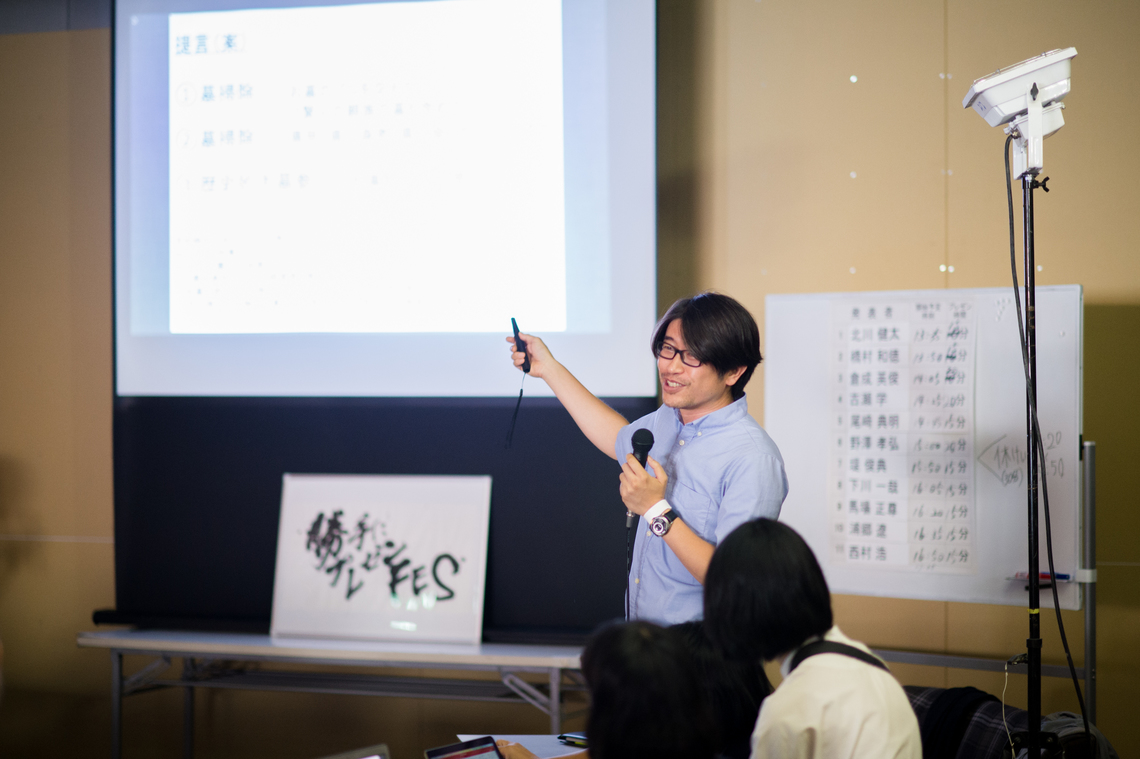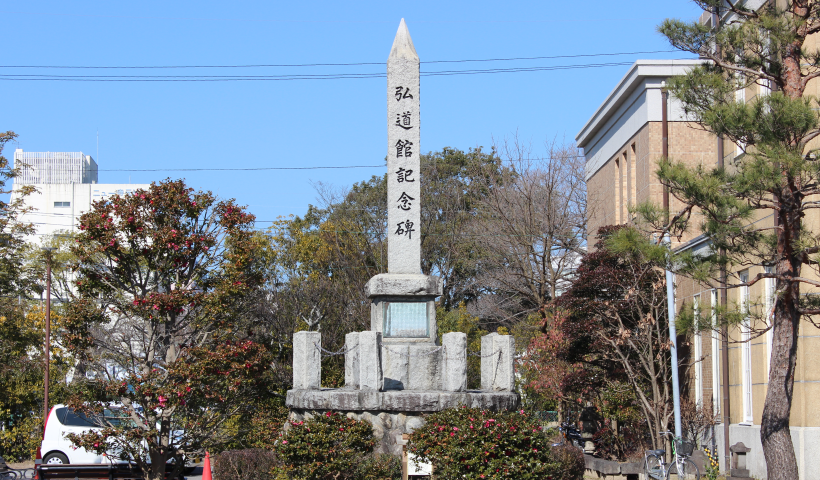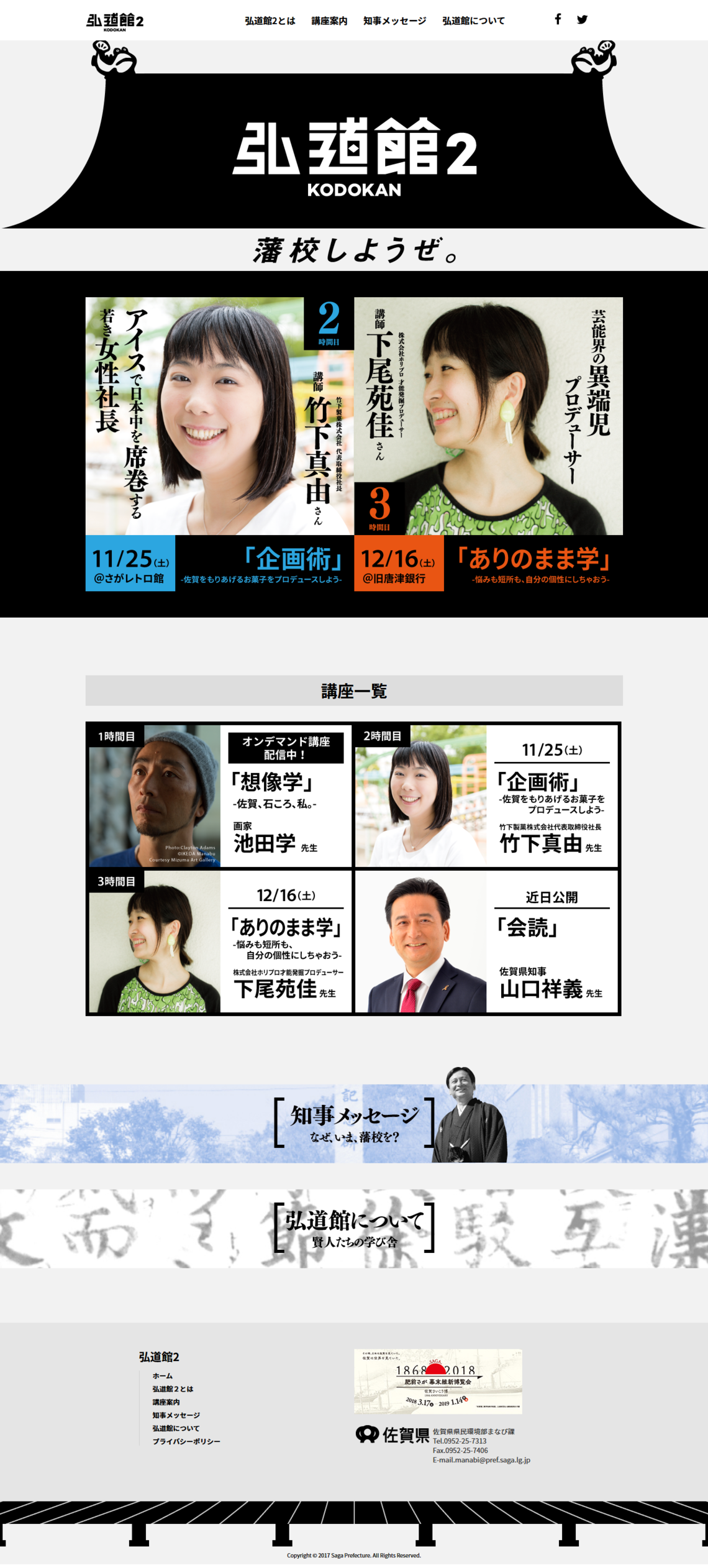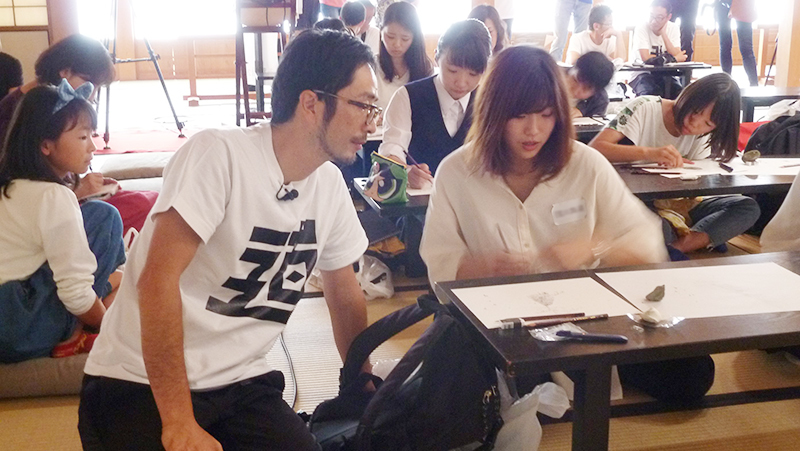Note: This website was automatically translated, so some terms or nuances may not be completely accurate.
Let's Start a Domain School! ~Behind the Scenes of "Kodo-kan 2," Saga Prefecture's 21st-Century Domain School~

Hidetoshi Kurashige
Creative Project Base Co., Ltd.
The education of domain schools.
Even if you hear that and think, "How old-fashioned!", you probably won't say, "That sounds interesting! Exciting! New!"
But what if you heard that the domain schools in various regions were already practicing the very education the world now focuses on—like the "Active Learning" championed by Japan's Ministry of Education, Culture, Sports, Science and Technology (MEXT), the OECD's "Key Competencies"※1, and the globally discussed "21st Century Skills"※2—about 200 years ago?
※1 Key Competencies: Comprising three abilities: the capacity to interactively utilize social, cultural, and technological tools; the ability to form relationships within diverse social groups; and the capacity to act autonomously.
※2 21st Century Skills: Strong "life skills" encompassing intellectual, mental, and physical capabilities, plus the ability to leverage technology.
Today, I'd like to share such a story using my hometown, Saga Prefecture, as an example.
It all began with a presentation to the governor at a movie theater
The trigger was a presentation at a movie theater.


A scene from the unsolicited presentation. Creators living in Tokyo with ties to Saga have the right to present. However, they must travel to Saga at their own expense.
Saga Prefecture hosts an event called "Saki-Katte Presentation FES," where anyone can propose anything to the governor. It was selected for the Good Design Award Best 100 this year, so some of you may be familiar with it.
The first event was held on July 15, 2015, at CIEMA, a movie theater in Saga City. I was invited (or rather, cornered?!) by my local seniors, Masataka Baba of Tokyo R Real Estate and architect Hiroshi Nishimura, to be part of the organizing committee. As a token effort to liven things up, I had to come up with at least one proposal to present.
But I suffer from "Project Making Syndrome." I can't help turning every idea into a project. And I always end up getting scolded by my juniors: "We're already swamped, and now you're starting another project!"
So this time, I devised the 'Just Extend My Existing Work' strategy. That way, it wouldn't look like I was adding more work! I decided to frame a project I'd been mulling over regarding education as a proposal from the 'Dentsu Inc. Active Learning: How About This? Research Institute' (and brilliantly, I avoided getting scolded!).
What I created was a proposal: What if we updated the Nabeshima clan's domain school, "Kodo-kan," for the 21st century?
Four Fascinating Episodes from the Legendary Domain School "Kodo-kan"
Let's briefly touch on the Kodo-kan here.

Kodo-kan was established about 250 years ago, on the orders of Nabeshima Harushige, the 8th lord of the Saga domain. It was modeled after the successful domain school "Jishukan" in Kumamoto at the time.
Its concept was: "Reform begins with education."
Times may have changed, but this principle remains strikingly relevant today.
The turning point came when the Confucian scholar Koga Kokudo submitted a memorandum on education titled "Gakusei Kankei" (Observations on Educational Policy). It reportedly stated, "The education budget should not be cut; rather, it should be tripled." In response, the 10th lord, Naomasa, upon assuming his position, ordered the enhancement of the Kodo-kan. This expansion led to prominent figures like Shigenobu Ōkuma and Shinpei Eto, considered sages of Saga, studying at the Kodo-kan. They later played active roles in the Meiji Restoration.
With that broad overview established, I'll now share the points I found particularly interesting.
Point 1: Their motto was self-study.
I love that word, "self-study."
You learn because you want to learn. You do it because you want to do it. That's the foundation of learning, right?
But are there any schools today that loudly proclaim such a principle?
In this 21st century.
Part 2: There were only 10 teachers for 1,000 students.
Why did it work? Because the seniors in between taught them. When you teach what you've learned yourself, your understanding deepens. It's the "half-learning, half-teaching" approach. People today say we need to learn together! But that was already being done since the 19th century.
Point 3: There were informal debate sessions where even feudal lords participated.
At the time, Hizen and Aizu were renowned for debate. One reason was the curriculum called "kaido" (group reading with discussion). The Four Books and Five Classics were used as textbooks then, and "kaido" involved reading them and discussing them.
This practice existed nationwide, but Hizen's was special. Amazingly, once a month, Lord Nabeshima himself would participate in completely informal debates. One day, the topic turned to coastal defense. A young samurai named Kume apparently angered Lord Nabeshima Naomasa, but his seniors told him, "You don't need to apologize," and as a result, nothing came of it.
Part 4: Iwakura Tomomi's son traveled all the way from Kyoto to study there.
Word of the Kodokan's reputation reached Kyoto, and upon hearing this, Iwakura Tomomi sent his son to study there. Relocating to the provinces for a better education. This is another story that resonates even today.
Other notable points include: admission regardless of social status; families of students who didn't study seriously faced salary reductions; outstanding young men were promoted to domain government positions; dinners consisted only of white rice and pickled radish. But this is getting long, so I'll save the rest for another time.
Five Rules for Establishing Kodo-kan 2
Well, I was deeply inspired by this historical story (even though I thought it was boring when I learned it in elementary school!), presented it to the governor, gained everyone's support, and Kodo-kan 2 is now moving forward toward realization.
For its establishment, we set these major rules:
1. Revive the Kodokan's methods for the present day.
"Self-directed learning" where seniors connected to Saga Prefecture teach.
We also revived "group reading sessions," with the governor participating instead of the feudal lord. And so on.
2. We won't build a permanent structure. We'll operate as a pop-up, holding sessions at interesting locations throughout Saga Prefecture.
Castles. Movie theaters. Old-style cafes. And so on. Changing locations makes classes far more interesting. And of course, keep costs low.
3. Stream online. Archive everything on the web.
Accessible nationwide. Usable for school lessons too.
4. No nostalgia.
We prohibit teaching history in a condescending manner, where older people lecture younger people.
This is actually a pretty important point.
5 Cover genres essential for the 21st century.
Back then, learning focused on Confucianism, Dutch studies, and artillery techniques. Today, it encompasses creativity, art, technology, business, science, nature experiences, sports, culture, tradition, global perspectives, collaboration, presentation skills, innovation, and entertainment.
Success is achieved if even one young person's eyes sparkle.
October 9, 2017. At Saga Castle's Honmaru, the 21st-century domain school "Kodo-kan 2" opened its doors.

The first instructor was Manabu Ikeda, a Saga-born painter active in the U.S. He's a star of Saga—no, the world—whose touring exhibitions at the Saga Prefectural Art Museum, Kanazawa 21st Century Museum of Contemporary Art, and Nihonbashi Takashimaya drew about 300,000 visitors.

Since his meticulous paintings based on imagination are so popular, we asked Mr. Ikeda to teach a class on "Imagination Studies." The workshop involved "picking up stones from Saga Castle, loading them with imagination, and painting." I'll write about that session, along with the upcoming lectures, in a future post.
To state the result simply: it was a huge success.
That's because we achieved both of our goals.
First, the young people's eyes were shining.
In fact, the goal we set with the Saga Prefectural Government was "to increase the number of young people with sparkling eyes, even if just one per workshop." Since it was far more than just one, we can truly call it a huge success.
The second goal is captured in a phrase posted on Twitter: "Saga, you're so sneaky."
Since we were putting in the effort, as a minor prefecture, Saga wanted to make other prefectures go "Whoa!" We wanted them to say, "Saga's so sneaky doing this." We talked about it, and then that exact phrase appeared on Twitter.
(And rightly so. That same day in Tokyo was the final day of Mr. Ikeda's solo exhibition. The venue, Nihonbashi Takashimaya, was packed with visitors. On that very same day in Saga, the artist himself was teaching a lesson on drawing from imagination to just 30 people, selected from applicants.)
We want to make young eyes sparkle even more! We want them to say, "Saga is so sneaky!" even more! So, we folks from this minor prefecture are scheming up all sorts of things for the next class.
Because. Our great predecessor, Shigenobu Ōkuma, who studied at the very original Kōdōkan, said this:
"The greatness of a nation lies not in its land, but in its people."
Yes, people are what matter. That's why we created Kodo-kan 2.
Wisdom, dreams, and drive. For Saga, and of course, for Japan.
Let's make our moves on the world, on the future.
What do you think?
The domain school.
Pretty cool, right?
[Announcement]
The second class period at Kodo-kan 2 features "Planning Techniques" by Mayu Takeshita, President of Takeshita Confectionery—a speech also referenced in Prime Minister Abe's address on women's empowerment. While registration for attendance is closed, it will be live-streamed on the Kodo-kan 2 website from 1:30 PM to 4:30 PM on November 25th. Please tune in.
Was this article helpful?
Newsletter registration is here
We select and publish important news every day
For inquiries about this article
Back Numbers
Author

Hidetoshi Kurashige
Creative Project Base Co., Ltd.
Representative Director/Creative Project Director
Joined Dentsu Inc. in 2000 and was assigned to the Creative Bureau. Since then, expanded and applied advertising skills to lead diverse projects across genres, including collaborations with corporate new business divisions, overall production of APEC JAPAN 2010 and the Tokyo Motor Show 2011, and the 400th anniversary project for Arita ware in Saga Prefecture. Launched Dentsu B Team in 2014 with employees possessing personal B-sides. In 2015, he established the Active Learning "How About This?" Research Institute. On July 1, 2020, he founded Creative Project Base Co., Ltd.

